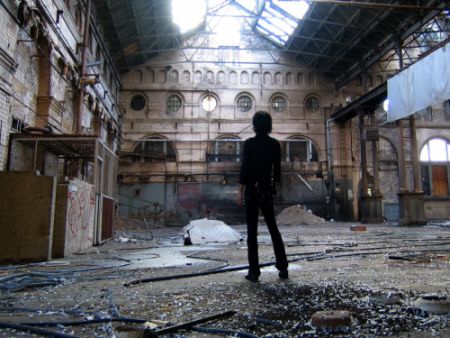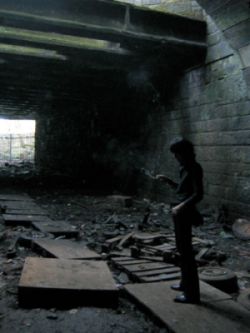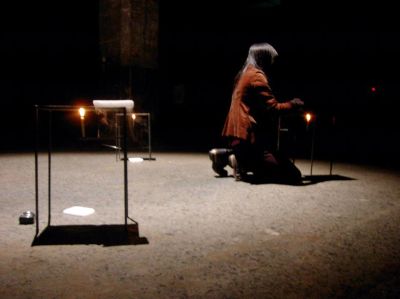
Building Sonic Structures [2014-04-25]Lethe (aka Japanese sound artists, subtle improviser and uneasy mood-setter Kuwayama Kiyoharu), creates a very distinctive & original sound art that sits somewhere between: manipulated field recordings, natural ambience, subtle improvising, and minimalist compositions. Many of the project recordings are base purely around the sounds of specially selected abounded factory spaces- and really what Kiyoharu creates in very unique with in the cannon of experimental music/sound craft. He kindly agreed to give M[m] an email interview to discuss the project.m[m]:Tell us a little bit about when you first became interested in creating your own sonic works, and is there any particular record or track that made you want to you start making your own stuff?
KK I got a four track cassette recorder from friend in the late 1980s.
This was starting point of my sonic work. At that time I had no knowledge of Avant-garde or Experimental music, I was just trying to creating my own sound. KK Although I have no memory of leaning towards creating a specific sort or form of music, I had interest in the sound effects and music for movies. KK The sound materials which were being used those early days were: a 1/2 scale violin, daily junk, and found objects, prepared guitar, etc. m[m]:You talk about starting your sonic works in the late 1980’s- how did these early works sound, and how would to categorise them?
KK The early work was mostly based around me attaching a contact microphone to various things and recording their sound.
Sound that is not going through the vibration of air is more dynamic than plan microphone recordings- I was hooked on this type of recording, and liked listening to the whisper of the thing-in-itself.
I then play it with a contact microphone and a variety of objects. For example, pot, kiln, knife, spoon in the kitchen , gathered founded metal pieces, etc.
Since the initial recordings were made using broken/ cheap equipment, the sound was close to Scum or Lo-Fi sound , & sometimes harsh noise. 
m[m]:You mention a interest in movie soundtracks- what type of thing do you enjoy?
KK I saw movies of various types, regardless of the genre when I was young.
Ones impression will change surprisingly when watching a film with the sound muted. My imagination spreads even if I listen to only music / sound effects.
It is very good for training for a certain way of thinking. m[m]: Is Lethe your first sonic project? and please tell us a little bit about how the project started & why you selected the projects name?
KK The Lethe project started in 1999. And before that I was performing solo and continuing collaboration with free jazz / free music players. KK It had become disagreeable to change the project name each time I created some thing, and I could use the Lethe name for duo or trios I featured in. After starting work of Catastrophe Point Series in 2001, it became a solo project. KK The projects name was chosen from the page of a random book in my bookshelf.
One of the reasons for chosing this name was to strengthen my anonymity.
However, since my real name, Kuwayama-Kijima, was used on (acoustic duo of cello and violin. 1999 – 2006 ) matrerail which I working on at the same time, I think that the effect was not ideal.
Now Lethe and my real name are properly used depending on the type of sound made.
m[m]:Many of your releases are called Catastrophe Point with a number after it- why do you use this title & what do you see as it’s meaning?
KK Catastrophe Point Series were released as single works, but I think it's one work as a whole.
This title also came randomly from a book.
In the case of Kuwayama-Kijima, the recorded date was used as a title. So for Catastrophe Point I use numbers instead.
I tried to make the Catastrophe Point Series close to essence of one word / or a simple phrase.

m[m]:I first became aware of Lethe’s work with the release of 2010’s Catastrophe Point 7 & 8- with it’s haunting & often eerier mix of industrial like field recordings, drones, and subtle minimalist piano elements. How does this work compare with you early work, and what do you think has changed sound wise in the project since you started?
KK For Catastrophe Point #1 through to Catastrophe Point #5, I was using a disused grain warehouse for recording. That warehouse had long reverberations, it's very important in my work, I learned how to use the building itself as an instrument.
Every time, I was able to spend long time at huge vacant warehouse for recording
I carried many instruments and non-musical instruments (metal, wood, sand, stone, etc. .)
However, this warehouse was closed by the city in 2003 and it became impossible to use.
After that, good recording locations were not found in Japan, I began to work outside the country from Catastrophe Point # 6 onwards.
m[m]:Much of your recent work is based around the sounds found in one building or industrial site- how do you go about choosing were to record? and how much pre planning do you do before you record?
KK I select the location by it having a certain echoing quality first, as described above.
I don't do pre planning, it is not possible to see the place in advance in case of recording in other countries .
I decide everything when I visit site.
m[m]:How much editing/ rearranging do you do after you have recorded elements on site? Many of the tracks on Catastrophe Point #9 & # 10 feature often layered & detailed sound texturing- do you create these on site, or do you manipulate the many recorded elements later in the studio?
KK The production method for the Catastrophe Point releases is very simple, and is made up only by overdubs.
I Do not do any digital processing other than very simple equalization.
Most of the work is done on the site. I pay close attention to the place where set up a microphones in particular. Setting them up to vary the texture and distance of the sound. m[m]:Your most recent release 2013’s Catastrophe Point #9 & # 10, saw you focus purely on building sounds, with no minimalist piano elements- tell us a little bit about why you decided to make this release purely sound based? And would you like to use piano elements again in future releases?
KK Excerpt from label description
”” The place selected for #9 is a huge abandoned building in the port of Montreal. Silo no.5 began to be built in 1906 and is unused since 1996.
I recorded on the upper floor of this grain elevator. Despite the fact there was no reverberant sound in that peculiar room, a long reverberation was obtained by installing a microphone in two of the silos. At the time of recording, since reverberation itself could not be heard at all, it was difficult for me to anticipate the final recorded sounds. There were only a few objects to produce sounds, just some metal sheets and rubber detritus. These conditions were a total new experience in the Catastrophe Point Series. "" KK Often my works are misunderstood as field recordings. However, I have not focused on the field recording elements.
Of course environment sounds will be picked up if one records in ruins or such places.
The reason for incorporated field recordings in the works is to not reject the environmental sounds that are recorded, treating theme on the same level as the other sounds.
It's about accept it and controlling contingency. 
m[m]:What kind of equipment do you use to record your work?
KK I bring only recorder and two of mono microphones to the sites.
m[m]:How long does it take you to create a release when you’re in the production/ dubbing stage? And how much material do you record to create a release?
KK In many cases, I will record about 10 ~ 20 hours for one work. Editing usually takes several months.
m[m]:How do you go about selecting a site to record at?
KK For Catastrophe Point Series, it chooses by whether a special reverberant sound is in the place.
Ruins which are not used for a long time are most desirable.
Many things used that can be used as sound material remain in such a place.
Moreover, it is useful to consider the concept called time. m[m]:What’s next for the project?
KK Until now, image and design of the sleeve were decided after finishing editing of recordings. For the next release I’ll chose the artwork first.
I like the idea of making a recording based on visuals.
Then I’ll publish it in a small numbered edition. All of the release will be handmade by myself, other than of course the Disc pressing.
And who knows I might perhaps do a vinyl or cassette tape based release instead. Thanks to Kiyoharu for his time & effort with the interview. Lethe/ Kuwayama Kiyoharu is located here. Catastrophe Point #9 & #10 was released in 2013 on Canada’s Oral Records, and we reviewed it here Roger Batty
| 
